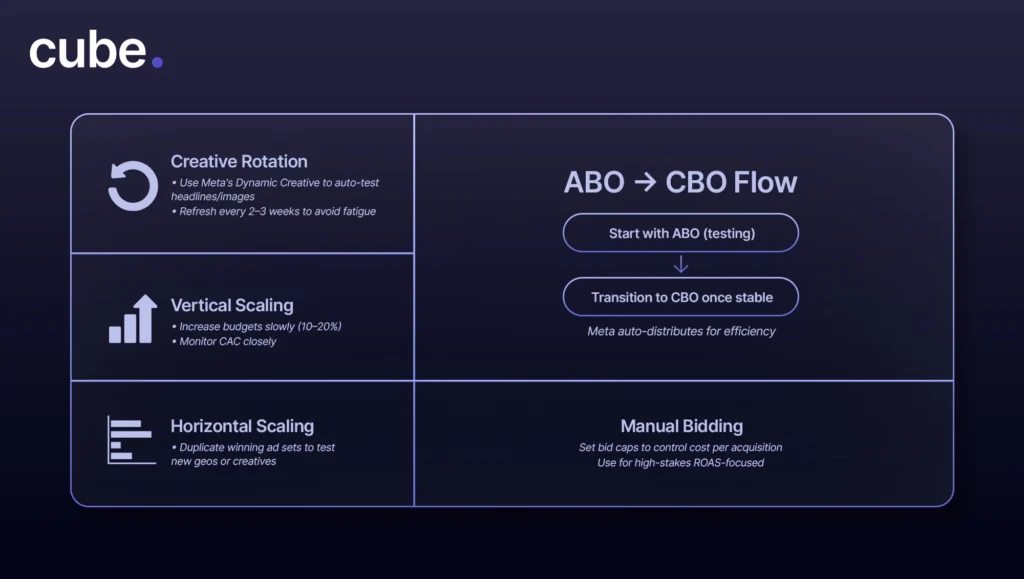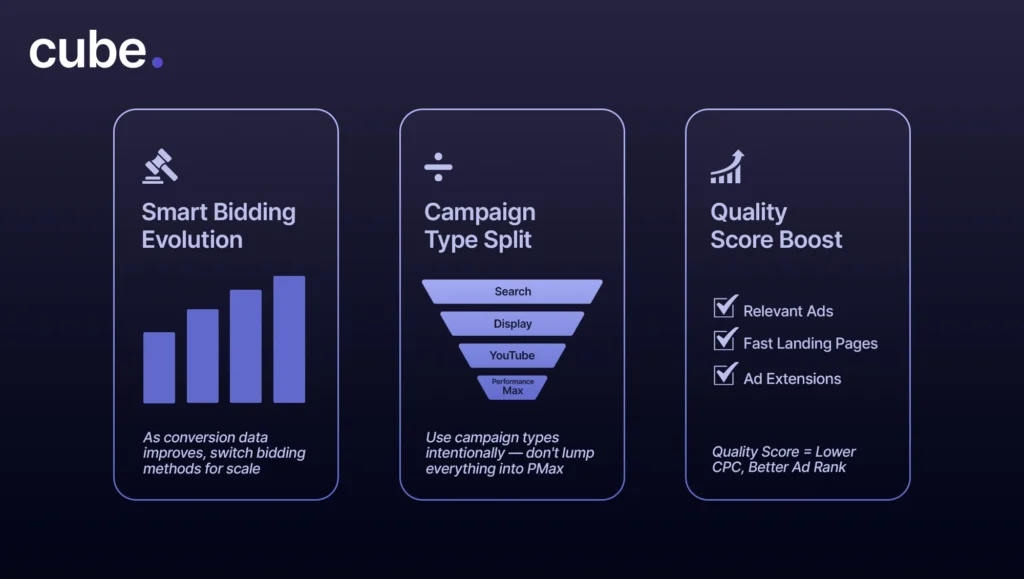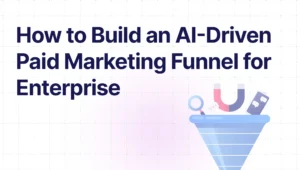We’ve all been there: your ad campaign is finally performing well, so you increase the budget expecting more results. But instead of scaling up, performance tanks and costs skyrocket. Suddenly, your customer acquisition cost (CAC) is out of control, and you’re left wondering what went wrong.
The truth is, scaling ads isn’t just about throwing more money at what’s working. It’s about knowing how to scale strategically. At Cube, we’ve helped brands avoid this exact pitfall by using AI-powered systems that optimize spend, streamline performance, and eliminate guesswork.
In this guide, we’ll explore why ad performance often drops during scale, what to do before increasing budgets, how to scale smartly on both Facebook and Google, and how AI can help you grow efficiently, without burning through your budget.
Why Costs Spiral When Scaling Facebook & Google Ads
Scaling ad campaigns isn’t just a matter of raising budgets; it often introduces new inefficiencies. Paid platforms like Google and Facebook run on auction systems, where increased competition drives up costs. As you expand targeting or push bids higher, your ads can start reaching broader, less qualified audiences, leading to lower conversion rates and rising costs.
Here’s what typically causes this breakdown:
- Auction competition increases, pushing CPMs higher
- Broader targeting dilutes audience relevance
- Bids extend beyond top-performing segments, inflating CPCs
- Budgets get wasted on low-intent clicks or poor placements
This isn’t just theory. WordStream data shows that CPCs rise steadily in competitive verticals on Google Search. Meta’s own benchmarks reflect similar inflation in CPMs and CPAs as advertisers scale spend.
Without a clear strategy, scaling quickly can mean paying more for less, and that’s where many campaigns lose efficiency.
Foundational Setup for Efficient Scaling
Scaling isn’t all about spending more. It’s about creating a structure that can sustain increased spending without collapsing. Get your foundation pieces in order before even reaching for the budget slider.
1. Account Structure
A messy account guarantees that you will burn through your budget fast. We suggest:
- Segmenting campaigns by stage of the funnel or audience intent
- Utilizing naming conventions to be able to easily track performance
- Splitting prospecting and retargeting into distinct campaigns
2. Conversion Tracking Hygiene
- Implement and validate the Meta Pixel and GA4 correctly
- Make use of Enhanced Conversions on Google to enhance signal precision
- Create custom events for high-value actions (and not merely transactions)
3. Creative & Feed Quality
- Keep product feeds clean, accurate, and dynamically refreshed
- Utilize modular creative templates to make scaling easier across formats
- Optimize ad copy to match landing page content for increased Quality Scores
4. Data Cleanliness
All AI-powered tools are dependent upon clean, high-quality data. If your inputs are dirty, the algorithms can’t perform optimally.
This initial step is not negotiable. Bypass it, and scaling will magnify the issues.
Facebook Ads: Scaling Without Breaking the Budget

Facebook offers powerful tools for scaling, but without the right strategy, growth can come at the cost of rising CAC and falling ROAS. To scale efficiently, you need to balance automation with control and make sure you’re optimizing across audience, creative, and budget strategies.
Here’s how to scale Facebook ads profitably:
1. Leverage Lookalike & Value-Based Audiences
Standard lookalike audiences are a great way to expand reach by targeting users who resemble your existing customers. But value-based lookalikes take it further by focusing on your highest-LTV customers to drive quality, not just volume.
- Use data from top purchasers or subscribers, not just all leads.
- Combine with pixel or CRM data to feed Meta better conversion signals.
- Result: Lower CAC while reaching more conversion-ready users.
2. Scale Creative Testing with Meta’s AI Tools
Creative fatigue is a major scaling killer. The more people you reach, the faster your creatives wear out. Combat this with automation:
- Dynamic Creative: Mix multiple headlines, images, and CTAs to find the best-performing combo automatically.
- Advantage+ Creative: Let Meta adapt your creatives per placement and user to boost engagement and conversions.
Scaling isn’t just about targeting, it’s about keeping creative fresh and conversion-focused at scale.
3. Scale Vertically and Horizontally (The Right Way)
- Vertical Scaling: Gradually increase the budget on high-performing ad sets, ideally by 10–20% every few days to avoid algorithm disruption.
- Horizontal Scaling: Duplicate winning ad sets to test new audiences, geos, or creatives without disturbing your original campaign structure.
Mix both methods to expand reach while keeping stable performance.
4. Use CBO and ABO Strategically
- CBO (Campaign Budget Optimization): Ideal for mature campaigns. Meta auto-distributes budget to top-performing ad sets, saving time and improving efficiency.
- ABO (Ad Set Budget Optimization): Better for testing. Gives you granular control to evaluate new audiences, placements, or messaging before scaling.
Our expert tip is to start with ABO for testing and then switch to CBO for scaling.
5. Control CAC with Manual Bidding
As you scale, Facebook’s default bidding can overspend to chase conversions. Manual bidding puts guardrails around your CPA goals:
- Use bid caps or cost caps to control spend and profitability.
- Ideal for campaigns with tight CAC targets or defined ROAS goals.
Manual bidding gives you more control when efficiency matters most.
6. Optimize for Conversion Events That Reflect Value
Don’t just optimize for top-of-funnel actions (like link clicks or page views). As you scale, train Meta’s algorithm to focus on high-intent actions:
- Use purchase or add to cart events, not just landing page views.
- Feed offline conversion data back into Meta (if available).
- Consider using custom events for subscription or lead scoring.
The better your signals, the better your scale.
7. Maintain Campaign Hygiene
Scaling can break campaigns that aren’t well-maintained:
- Consolidate overlapping ad sets to reduce auction competition.
- Pause underperformers quickly to avoid budget bleed.
- Refresh creatives regularly to avoid fatigue.
- Use exclusions to avoid targeting repeat customers unless upselling.
Scaling Facebook ads is part strategy, part structure, and part system, and Cube AI tools can help automate and optimize across all three. Whether you’re managing dozens of campaigns or just starting to ramp up, smart scaling helps you grow revenue, not just spend.
Google Ads: Growing Your Reach Without Overspending

Scaling Google Ads can deliver massive returns, but only when done with precision. The platform offers a wide range of campaign types (Search, Display, YouTube, Shopping, Performance Max), each with unique mechanics and scaling requirements. Without a strategic approach, scaling can quickly lead to ballooning CPCs, wasted impressions, and poor lead quality.
Here’s how to scale your Google Ads intelligently (without breaking your budget):
1. Choose the Right Bidding Strategy for Your Stage
Start with a bidding method that aligns with your data maturity:
- Manual CPC is ideal for newer accounts or test campaigns where you want control over bids and keyword-level optimization.
- Smart Bidding strategies (like Maximize Conversions, Target CPA, or Target ROAS) use Google’s machine learning to bid dynamically based on conversion probability. These work best when you’ve built up conversion history and reliable tracking signals.
Pro tip: Use Enhanced CPC (ECPC) as a middle ground; it lets Google adjust your manual bids when it detects higher intent, without full automation.
2. Segment Campaign Types for Clean Optimization
Scaling effectively means separating campaign types:
- Search: Best for high-intent users. Best for direct lead generation or sales. Optimize tightly around keywords and match types.
- Display: Great for retargeting or top-of-funnel brand awareness. Lower intent, so watch your placements and audience segments closely.
- YouTube: Ideal for storytelling, education, and remarketing. Strong for building trust and warming up leads.
- Performance Max (PMax): Combines all of Google’s channels into one campaign. Powerful, but less transparent. So use this when you have clear conversion goals, strong creative assets, and budget to test.
Keep these campaigns separate, so you can scale or optimize each one without polluting data or overlapping spend.
3. Expand Keywords Strategically
Scaling search doesn’t mean going broad all at once:
- Start with exact and phrase matches for high intent and tighter control.
- Gradually introduce broad matches, but only once you have strong conversion data and use Smart Bidding + negative keywords to filter low-quality traffic.
- Regularly audit search terms and pause non-performing queries to maintain efficiency.
Remember: keyword expansion should follow proven success, not lead it.
4. Focus on Quality Score to Lower CPC
Google rewards relevance. A higher Quality Score means lower CPCs and better placement. To improve it:
- Write ads that tightly align with your keywords and intent
- Optimize landing pages for mobile performance, speed, and conversion clarity
- Improve ad extensions (sitelinks, callouts, structured snippets) to boost visibility and click-through rates
Improving Quality Score is one of the most cost-effective ways to scale.
5. Invest in Conversion Tracking & Attribution Early
You can’t scale what you can’t measure. Make sure your conversion tracking is airtight:
- Set up primary and secondary conversions (e.g., purchases, signups, demo bookings, scroll depth)
- Use Google Tag Manager, GA4, and Offline Conversion Imports if needed
- Customize attribution models to match your sales cycle (avoid relying only on last-click)
Strong tracking gives Smart Bidding the data it needs, and gives you the confidence to scale spend.
6. Budget Scaling: Incremental and Intent-Led
Avoid the temptation to double budgets overnight. Instead:
- Scale incrementally (10–20%) every few days to avoid disrupting campaign learning
- Allocate more spend to top-performing campaigns and keyword groups
- Don’t assume higher budget = better performance. Focus on spending where intent is high and efficiency is proven
If CAC starts rising without an improvement in volume or quality, pull back and analyze.
7. Use Audience Layers and Intent Signals
Scaling search and PMax works even better when paired with audience targeting:
- Layer in-market, affinity, or custom intent audiences on Search campaigns to improve relevance.
- Use remarketing lists to re-engage previous site visitors with stronger offers.
- For YouTube and Display, lean into customer match and similar audiences for higher ROAS.
Audience signals tell Google who’s most likely to convert, making your spend more efficient.
8. Creative Scaling with Assets That Convert
Don’t overlook ad creative, especially in Performance Max and YouTube:
- Use multiple headline/description variations in responsive search and display ads.
- Provide a full asset mix (videos, images, CTAs) in PMax so Google can optimize across placements.
- Update creatives regularly to avoid fatigue and drop-offs.
Scaling isn’t just about reach, it’s about keeping messaging effective as audiences grow.
AI’s Role in Cost-Controlled Ad Scaling
Scaling paid advertising isn’t simply a matter of budget; it’s about accuracy. This is where artificial intelligence can help, revolutionizing the way we scale campaigns without increasing costs.
AI software enables us to use predictive spend allocation, determining which campaigns or audiences are most likely to drive results and automatically moving dollars to them. That means your money goes where it will have the greatest effect.
Another major advantage is creative fatigue detection. AI tracks engagement and alerts when your ads are tiring out, so new creatives can come in before performance erodes. Real-time bid changes are another potent feature. AI adjusts bids automatically according to time of day, device, or user behavior, improving performance without human intervention.
Finally, AI assists with campaign pacing and outlier detection, warning you of spikes or dips in performance so you can respond fast and minimize waste. With AI, there’s smarter, more efficient scaling. Extracting more value from your Facebook ads spend and Google Ads budget without wasting a single dollar.
Retargeting & Funnel Strategies That Don’t Drain Budgets
Retargeting is still one of the most affordable ways to convert leads. When executed with precision, you can scale profitably without bloating your budget. This is how we do it:
- Segment by Funnel Stage
Tailor your ad messaging to where users are in the journey. For instance, use educational or benefit-focused messaging for mid-funnel audiences (like video viewers) and conversion-driven CTAs for bottom-funnel users (like cart abandoners).
- Cross-Platform Retargeting
Retarget users across platforms to stay top-of-mind. Serve Google Ads to users who first engaged on Facebook, and vice versa, to create a seamless cross-channel experience.
- Frequency Capping
Avoid ad fatigue by limiting how often users see the same ad. Smart capping improves engagement and keeps your brand feeling fresh.
- Sequential Messaging
Show different value propositions or CTAs at each touchpoint. Sequential ads build narrative and trust, helping guide users from awareness to conversion without sounding repetitive.
When you map your funnel across platforms and tailor your messaging accordingly, your ad dollars work harder and go further.
Measurement Frameworks for Scalable Success
Scaling blind is like flying without instruments. Performance relies on consistently tracking the right metrics.
Metrics that Matter:
- CAC (Customer Acquisition Cost)
- ROAS (Return on Ad Spend)
- Blended metrics across channels
Tools We Use:
- GA4 for cross-channel tracking
- Meta Experiments for true A/B testing
- Cube to blend data and forecast on future channel performance
Other Recommendations:
- Forget about last-click attribution! Use data-influenced, or data-position-based methods
- Use lift tests until your spending gets significant
- Build feedback loops to improve on learnings
Scaling becomes duplicable when measurement becomes second nature.
Common Mistakes When Scaling (and How to Avoid Them)
If your ads aren’t working the way you want them to, these might be the reasons:
- Scaling too quickly and not testing: Slowly scaling > aggressively scaling.
- Increasing Google Ads budget too fast: Allow campaigns to stabilize before scaling any budgets.
- Creatively fatigued: Rotate creatives every 2-3 weeks and maintain campaign performance.
- Too much use of broad targeting or Smart Campaigns: No control = Excessive spending.
- Not addressing mobile UX: Ensure pages load quickly and are clean and focused.
It is cheaper to prevent than to fix.
Scaling Smart, Not Just Big
Scaling your ad campaigns doesn’t have to involve runaway budgets and decreasing returns. When using the right structure, intelligent tools, and a disciplined methodology, you can have added impact without the added waste.
To summarize:
- Start with a strong foundation of clean data and structure
- Implement Facebook and Google scaling strategies focused on efficiency.
- Use AI to manage budget allocation and in-flight optimizations
- Retarget strategically across funnel stages and retargeting platforms.
- Understand the right metrics, test often, and iterate
At Cube, we help brands scale using AI-powered paid media intelligence that adapts in real-time to market shifts. Need help scaling your paid strategy? Contact our team for a customized audit before your next budget increase.


